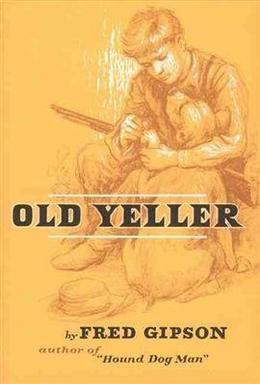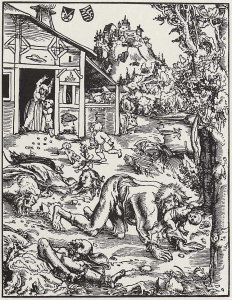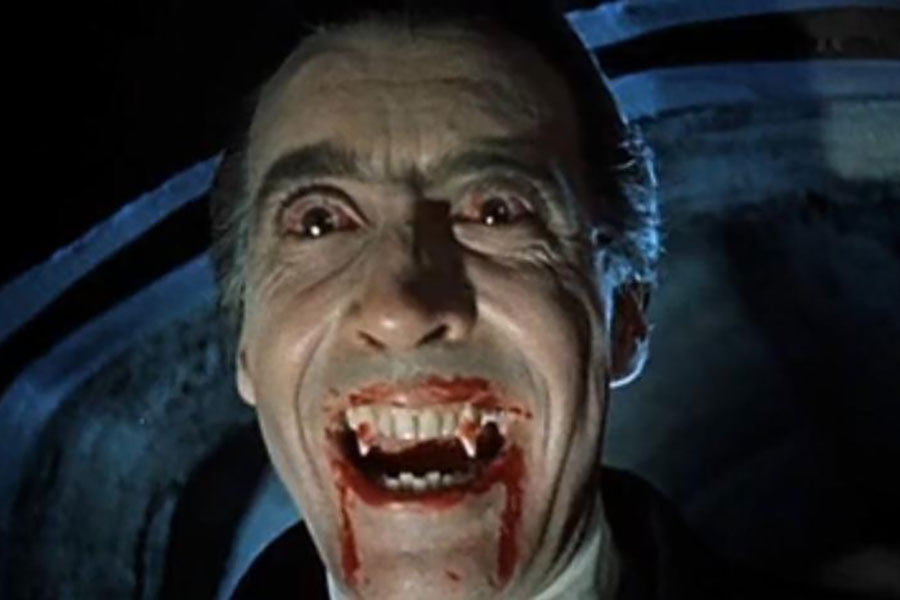It may seem odd to associate such a horrific and deadly disease as rabies with “popularity.” It is anything but! Yet since prehistoric times that is exactly how humankind has dealt psychologically with our most memorable tragedies and primal fears: by telling stories about them and depicting them in our art. This is the very essence of “whistling past the graveyard,” as the old phrase goes.
In last month’s article about rabies we wrote:
The term rabies comes from a Latin word meaning “madness.” Surely that is one of the reasons this pathogen has always inspired so much fear: for in the process of killing its host, it first destroys the mind, which is the seat of an individual’s personality. Indeed, some of the most familiar and frightening horror creatures in popular culture—vampires, werewolves, and zombies—are derived from mythologies that harken back to the days when a normal, healthy person could be suddenly transformed into a raving, drooling monster just from the bite of a maddened beast.
That inspired us to explore some of the ways that the rabies virus has historically staked a claim in our cultural collective conscious.
Realistic Depictions of Rabies
 For many people alive today, no doubt their first “exposure” to rabies came in the form of a book (and later a Disney movie of the same title)—namely Old Yeller, the tragic tearjerker of a tale by Fred Gipson published in 1958. Whose heart is so hard that it doesn’t break when young Travis is forced to put down his beloved dog after it gets bitten while saving the Coates family from a rabid wolf? For many, this was their first introduction to the tragic consequences of the disease.
For many people alive today, no doubt their first “exposure” to rabies came in the form of a book (and later a Disney movie of the same title)—namely Old Yeller, the tragic tearjerker of a tale by Fred Gipson published in 1958. Whose heart is so hard that it doesn’t break when young Travis is forced to put down his beloved dog after it gets bitten while saving the Coates family from a rabid wolf? For many, this was their first introduction to the tragic consequences of the disease.
 Another classic is the 1966 film Gilberto Gazcón Rage starring Glenn Ford and Stella Stevens. The movie tells the tale of a bitter loner, Dr. Reuben, who lives and practices in a remote Mexican border town.
Another classic is the 1966 film Gilberto Gazcón Rage starring Glenn Ford and Stella Stevens. The movie tells the tale of a bitter loner, Dr. Reuben, who lives and practices in a remote Mexican border town.
Soon after a man dying of rabies staggers into town, Dr. Reuben himself is bitten by the same rabid dog. He must now get others to help him reach a city hospital within 48 hours before the disease becomes incurable.
This scene from the film, while perhaps overly dramatic, is not entirely inaccurate in portraying the effects of the disease on an infected man:
What is metaphorically interesting about this film is that the rabies infection that could eventually kill Dr. Reuben is actually less deadly than the existential bitterness that cuts him off from all who would love him. As Stella Stevens’ character Perla angrily tells him, “I thought you were alive, but you’re not even breathing.”
 An even more contemporary depiction of rabies run completely amok can be found in Cujo, the hit 1981 Stephen King psychological horror novel (and of course, inevitably, film adaptation). In this story, when a lovable 200-pound Saint Bernard is bitten by an infected bat and then turns on every human in sight, all hell breaks loose.
An even more contemporary depiction of rabies run completely amok can be found in Cujo, the hit 1981 Stephen King psychological horror novel (and of course, inevitably, film adaptation). In this story, when a lovable 200-pound Saint Bernard is bitten by an infected bat and then turns on every human in sight, all hell breaks loose.
Did I mention the dog weighs 200 pounds? It’s hard to imagine anything more terrifying.
But stories about rabies are not necessarily all dark and morbid. They can be funny too! One of the most humorous has to be the Seinfeld sitcom episode “The Glasses” (season 5, episode 3), when Elaine is bitten by a strange dog and becomes convinced she has contracted rabies. It is the perfect illustration of hypochondria taken to an absurd extreme. And with absolutely no help from her doofus friends, hilarity ensues. Rabies truly is no laughing matter; but we hope you enjoy these scenes anyway from that episode:
Rabies in Myth and Imagination

Here’s where things get really interesting. As alluded to above, many of our favorite horror monsters surely get their inspiration from the circumstances and symptoms of rabies infection.
Werewolf myths (and indeed any form of lycanthropy), which date back at least to the Middle Ages, are an obvious example: a man (or woman) gets bitten by a mysterious wolf-like animal and in turn transforms into a bloodthirsty beast.
In a similar vein, zombie stories seem to have completely taken over modern entertainment. The “walking dead” seem to be everywhere these days, from the lumbering creatures in George Romero’s 1968 classic, Night of the Living Dead, to the White Walkers of the wildly popular Game of Thrones series. As with werewolves, in many of these manufactured mythologies all it takes is a single bite from an infected zombie to transfer the infection to the bitee and transform that person into a crazed, flesh-eating monster.
Some of the more thoughtful books, graphic novels, TV shows, and films about zombies take some pains to avoid relying on a supernatural explanation for post-mortem perambulation, and instead make a direct, vaguely scientific connection between rabies and zombiehood. For example, the so-called “T-virus” featured in the Resident Evil game and film franchise is a manufactured pathogen arguably modeled on the rabies virus, both in its transmissibility and its effect on humans.
Similarly, Danny Boyle’s acclaimed 2002 post-apocalyptic horror film 28 Days Later centers on an artificially engineered “Rage” virus which, much like advanced rabies, is highly contagious and causes humans to become uncontrollably frenzied and aggressive. The symptoms of “Rage” infection resemble those of rabies, including discoloration of the eyes, unpredictable behavior, the urge to bite, and the spread of the virus through saliva. As this trailer for the film suggests, the difference is that infection with this fictional, fast-moving pathogen begins with exposure and infection, but ends with epidemic, evacuation, and ultimately country-wide devastation.
 Finally vampirism, as personified in Bram Stoker’s deathless Count Dracula, must surely be considered the granddaddy of all rabies-inspired mythologies. Indeed, in a 1998 scholarly paper, published in the journal Neurology, researcher Dr. Juan Gómez-Alonso lays out the case for linking rabies with vampire folklore. He notes that areas of Eastern Europe were panicked by reports of bloodthirsty undead in the early 1730s, a few years after a major rabies epidemic was recorded in Hungary among dogs and wild animals.
Finally vampirism, as personified in Bram Stoker’s deathless Count Dracula, must surely be considered the granddaddy of all rabies-inspired mythologies. Indeed, in a 1998 scholarly paper, published in the journal Neurology, researcher Dr. Juan Gómez-Alonso lays out the case for linking rabies with vampire folklore. He notes that areas of Eastern Europe were panicked by reports of bloodthirsty undead in the early 1730s, a few years after a major rabies epidemic was recorded in Hungary among dogs and wild animals.
As the neurologist points out, many of the explicit symptoms of rabies—e.g., a tendency to bite and an aversion to strong smells and mirrors (which could be due to a rabies sufferer’s hypersensitivity to external stimuli)—bear an uncanny resemblance to historical descriptions of vampires.
According to Gómez-Alonso, in addition to turning victims into vampires by biting them, there are plenty of other reasons to diagnose vampires as “rabid.” For example, since rabies can affect portions of the brain that govern normal, nocturnal sleep patterns, victims suffer from insomnia; while vampires are said to wander in the night. Moreover, the animals associated with vampires—wolves and bats—are common rabies carriers. And because rabies victims have trouble swallowing, bloody saliva sometimes drips from their mouths.
Whether or not you buy this theory, there is no question that you have little to fear from fictional creatures like vampires, but much to fear from an equally horrifying microbe like rabies—which is real!
For that reason, take no chances, and make sure your pets’ rabies shots are up to date. For the sake of you, your family, and your pets, always be sure to get them vaccinated regularly and on schedule according to local regulations.
And then let your pets wear our Ketchum Mfg. rabies tags proudly!








